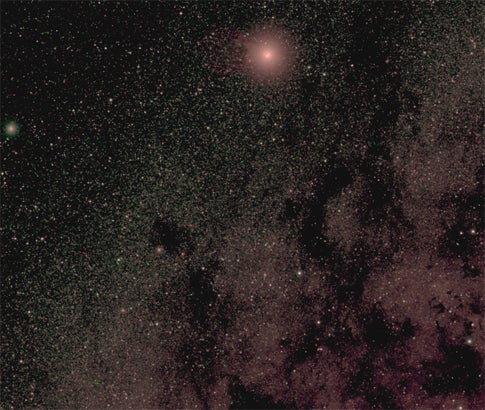Earlier this month ESA’s Rosetta had a first look at asteroid 21-Lutetia, one of the targets of its long mission. The onboard camera OSIRIS imaged the asteroid passing through its field of view during the spacecraft’s gradual approach to Mars. The planet will be reached on February 25, 2007 for the mission’s next gravity assist.
During its long trek to its final destination (comet 67P Churyumov-Gerasimenko), Rosetta is planned to study two asteroids — 2867-Steins and 21-Lutetia, both lying in the asteroid belt between the orbits of Mars and Jupiter. Asteroids, as well as comets, carry important information about the origin of the Solar System — a better understanding of which is one of the primary goals of Rosetta.
The two asteroids will be visited at close range in September, 2008 and July, 2010, respectively, but the Rosetta scientists have already taken the opportunity to collect preliminary data about them. This opportunity will help scientists to better prepare for the broader observation campaigns of the two asteroids to come at a later stage.
Rosetta imaged Steins on March 11, while Rosetta first imaged Lutetia during a 36-hour observation campaign on January 2 and 3, 2007, when the spacecraft was flying at about 245 million kilometers from the asteroid. OSIRIS, the Optical, Spectroscopic, and Infrared Remote Imaging System mounted onboard the Rosetta orbiter, was switched on for this remote sensing observation.
Lutetia can be seen as the near-stationary spot visible at the center of the animated sequence presented here (see below). The scattered light spots seen in the movie are cosmic ray events, that is high-energy cosmic radiation hitting the detectors of the OSIRIS camera.
Little is known about Lutetia and Steins. Actually, very little is known about asteroids in general. Out of the many millions of asteroids that populate the Solar System, only a few have been observed so far from nearby.
According to what we know so far, Steins and Lutetia have rather different properties. Steins is relatively small, with a diameter of a few kilometers. Lutetia is a much bigger object, about 100 kilometers in diameter.
The Lutetia observation this month was aimed at pre-characterizing the rotation direction of the asteroid. This can be done by the study of the so-called ‘light curve’ of the asteroid — by analyzing how the light emitted by the observed object changes intensity for the observer, one can deduce in what direction the object rotates. Scientists are now busy in analyzing the OSIRIS data to build the light curve of Lutetia.










